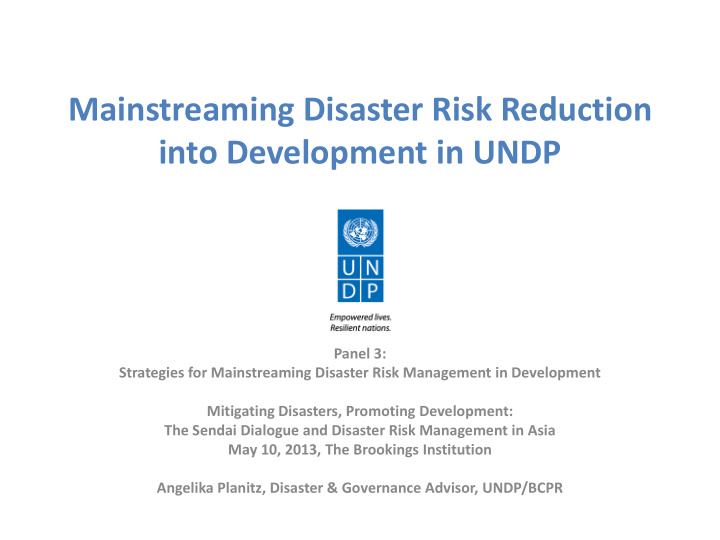



Mainstreaming Disaster Risk Reduction into Development in UNDP Panel 3: Strategies for Mainstreaming Disaster Risk Management in Development Mitigating Disasters, Promoting Development: The Sendai Dialogue and Disaster Risk Management in Asia May 10, 2013, The Brookings Institution Angelika Planitz, Disaster & Governance Advisor, UNDP/BCPR
Presentation Outline I. UNDP & Disaster Risk Reduction II. DRR Mainstreaming: a priority for UNDP III. DRR Mainstreaming explained IV. UNDP support for DRR Mainstreaming V. In closing…
I. UNDP & Disaster Risk Reduction 1998: UN General Assembly mandate (A/RES/52/12 B) 2001: Establishment of Bureau for Crisis Prevention and Recovery Portfolio: UNDP supports disaster risk reduction and recovery in about 50-60 countries annually, with average annual expenditures of over $ 150 million UNDP’s Annual Business Plan and Strategic Plan 2014 -2017 feature disaster reduction and recovery in predominant way Crisis Prevention and Recovery (CPR) is one of UNDP’s four core practice areas
II. DRR Mainstreaming – Why is it a priority for UNDP?
Development at Risk from Disasters Rising impact of disasters over the past 30 years: 3.3 million people killed – 50% of deaths occur in poor countries, but they accounted for only 9% of disasters Economic cost of disasters has tripled – Over USD 1.2 trillion of economic loss occured in developing countries: equivalent to a third ODA Disasters push people into poverty – Poverty levels after the Haiti 2010 earthquake and Djibouti 2011 drought returned to early 2001/2003 levels
Development contributes to Disaster Risk Disaster Risk Increasing Vulnerability Inappropriate land use Environmental degradation Multi-Hazard Context Unplanned urbanization Seismic and volcanic Exposure of population & assets activities in hazardous locations Cyclones Economic inequalities Floods Landslides Weak social organization Coastal Erosion Deficient infrastructure Drought … Weak governance systems Magnified by climate Flawed change Development Process
Solutions for disaster and climate resilient development… Pursuing disaster reduction, adaptation and sustainable development as mutually supportive goals Considering risk reduction as an essential investment in sustainable development, not as an additional cost Corrective development planning that ensures development does not generate risks … in short: DRR Mainstreaming
III. Mainstreaming explained... Main stream? Side stream?
Mainstreaming requires…
Mainstreaming DRR/CCA Into Development Process Identify Natural National Hazard Risks Development Plans/Strategies Incorporate Evaluate Risks DRR/CCA into: Policies Accept Risks? Regulations Yes No Budget Sector Plans Monitor Identify Ways to Prevent Programmes or Manage Risks & Review (DRR/Adaptation Options) Projects Prioritise DRR/ Adaptation Options
IV. UNDP support for DRR Mainstreaming
Vehicles for UNDP support to DRR Mainstreaming … Comprehensive national disaster risk reduction programs Tailor-made technical assistance and policy advise Knowledge products and training courses Partnerships with specialized institutions Global advocacy efforts
Comprehensive disaster risk reduction programs Since 2005 UNDP: Supported over 45 National DRM Authorities Integrated DRR into national development policies and frameworks in over 30 countries Strengthened legislative frameworks that foster DRM in 58 countries Supported climate risk management programs in 22 countries Helped establish 30 Disaster Loss Databases
UNDP Mainstreaming Tools “Unpacking” the process of DRR mainstreaming DRR Mainstreaming Framework & Country Specific Guidelines
Partnerships for Mainstreaming (1) MADRiD: Mainstreaming Adaptation and Disaster Reduction into Development with UNISDR, and the Government of Korea, since 2012 CADRI: Capacity for Disaster Reduction Initiative with UNOCHA, UNICEF, WFP, WHO, and GFDRR and IFRC as observers DRR Law Project with IFRC to review DRR integration into national and sub-national legislative and regulatory frameworks
Partnerships for Mainstreaming (2) DRR integration into United Nations Development Assistance Frameworks (UNDAF) with UNDOCO and UNISDR – 2009: Guide for UN Country teams to integrate DRR into UNDAFs and Common Country Assessments (CCA) – Technical assistance to UN Resident Coordinators and Country team to mainstream DRR into UNDAF – Training materials and workshops for UN Country teams – Since 2009, 54 UN Country Teams officially published their UNDAF - of these, 50 UNDAFs incorporate DRR
Global Advocacy for DRR Mainstreaming Integration of DRR and conflict prevention into the post- 2015 development agenda : UNDP is co-leading consultations with UNISDR, UNICEF and UN Peace Building Support Office Political Champions Group: UNDP and UNOCHA are leading a UN system process to improve how development and humanitarian agencies work together and cooperate with governments and donors towards resilience in countries at risk from natural hazards HFA 2: UNDP supports the consultation process and supports the development of the successor to the HFA based on its practical experience.
V. In closing… DRR mainstreaming for building resilience requires sustained engagement More appropriate and long-term funding mechanisms needed; i.e. development and climate change funds Use recovery as an opportunity and entry point for DRR mainstreaming Foster integrated solutions by working across disciplines to address complex issue of risk, especially DRR and adaptation
Thank you… Contact: angelika.planitz@undp.org UNDP - BCPR 1 United Nations Plaza, DC-1 New York
Recommend
More recommend